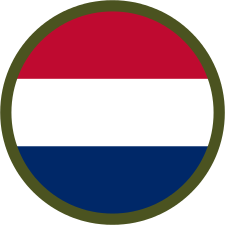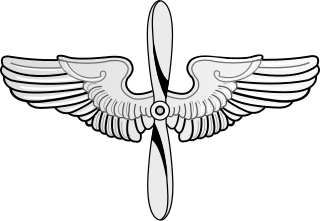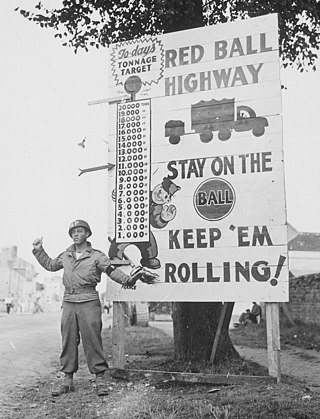
The Army of the Republic of North Macedonia is the military of North Macedonia. The army is organized, prepared and trained to conduct armed struggle and combat and other actions to achieve its constitutional function of defending the independence and territorial integrity of North Macedonia. The army consists of the ground forces and the air force, which are further divided into branches and services. The army has a permanent composition and reserve forces. Since 2005, it is a fully professional defense force compatible with NATO standards. In 27 March 2020, North Macedonia joined NATO as the 30th member.

Logistics is the part of supply chain management that deals with the efficient forward and reverse flow of goods, services, and related information from the point of origin to the point of consumption according to the needs of customers. Logistics management is a component that holds the supply chain together. The resources managed in logistics may include tangible goods such as materials, equipment, and supplies, as well as food and other consumable items.

Charles Gates Dawes was an American banker, general, diplomat, musician, composer, and Republican politician who was the 30th vice president of the United States from 1925 to 1929 under Calvin Coolidge. He was a co-recipient of the Nobel Peace Prize in 1925 for his work on the Dawes Plan for World War I reparations.

The American Expeditionary Forces (AEF) was a formation of the United States Armed Forces on the Western Front during World War I, comprised mostly of units from the U.S. Army. The AEF was established on July 5, 1917, in France under the command of then-Major General John J. Pershing. It fought alongside French Army, British Army, Canadian Army, British Indian Army, New Zealand Army and Australian Army units against the Imperial German Army. A small number of AEF troops also fought alongside Italian Army units in 1918 against the Austro-Hungarian Army. The AEF helped the French Army on the Western Front during the Aisne Offensive in the summer of 1918, and fought its major actions in the Battle of Saint-Mihiel and the Meuse-Argonne Offensive in the latter part of 1918.

Ferdinand Foch was a French general and military theorist who served as the Supreme Allied Commander during the First World War. An aggressive, even reckless commander at the First Marne, Flanders and Artois campaigns of 1914–1916, Foch became the Allied Commander-in-Chief in late March 1918 in the face of the all-out German spring offensive, which pushed the Allies back using fresh soldiers and new tactics that trenches could not withstand. He successfully coordinated the French, British and American efforts into a coherent whole, deftly handling his strategic reserves. He stopped the German offensive and launched a war-winning counterattack. In November 1918, Marshal Foch accepted the German cessation of hostilities and was present at the Armistice of 11 November 1918.

The German spring offensive, or Kaiserschlacht, also known as the Ludendorff offensive, was a series of German attacks along the Western Front during the First World War, beginning on 21 March 1918. Following American entry into the war in April 1917, the Germans decided that their only remaining chance of victory was to defeat the Allies before the United States could ship soldiers across the Atlantic and fully deploy its resources. The German Army had gained a temporary advantage in numbers as nearly 50 divisions had been freed by the Russian defeat and withdrawal from the war with the Treaty of Brest-Litovsk.

The Battle of Saint-Mihiel was a major World War I battle fought from 12–15 September 1918, involving the American Expeditionary Forces (AEF) and 110,000 French troops under the command of General John J. Pershing of the United States against German positions. The U.S. Army Air Service played a significant role in this action.

The United States Army Air Service (USAAS) was the aerial warfare service component of the United States Army between 1918 and 1926 and a forerunner of the United States Air Force. It was established as an independent but temporary branch of the U.S. War Department during World War I by two executive orders of President Woodrow Wilson: on May 24, 1918, replacing the Aviation Section, Signal Corps as the nation's air force; and March 19, 1919, establishing a military Director of Air Service to control all aviation activities. Its life was extended for another year in July 1919, during which time Congress passed the legislation necessary to make it a permanent establishment. The National Defense Act of 1920 assigned the Air Service the status of "combatant arm of the line" of the United States Army with a major general in command.

The Siegfried Line campaign was a phase in the Western European campaign of World War II, which involved actions near the German defensive Siegfried Line.

The Transportation Corps is a combat service support branch of the U.S. Army. It is responsible for the movement of personnel and material by truck, rail, air, and sea. It is one of three U.S. Army logistics branches, the others being the Quartermaster Corps and the Ordnance Corps. The Corps was established in its current form on 31 July 1942, with predecessor services dating back to the American Civil War. The Transportation Corps is currently headquartered at Fort Gregg-Adams, Virginia. The officer in charge of the branch for doctrine, training, and professional development purposes is the Chief of Transportation (CoT) and Commandant of the US Army Transportation School, currently held by COL Beth A. Behn. The Corps's motto is "Nothing Happens Until Something Moves".

Lieutenant General James Guthrie Harbord was a senior officer of the United States Army and president and chairman of the board of RCA. During World War I, he served from mid-1917 to mid-1918 as chief of staff of the American Expeditionary Forces (AEF), commanded by General John J. Pershing, before commanding a brigade and briefly a division and then the Services of Supply of the AEF. In the former role he was, in the words of former soldier-turned historian David T. Zabecki,
The U.S. Army's first modern operational-level chief of staff in a combat theater, and he would be the model for all others who followed. He played a key role in developing the staff structure and organization used throughout the U.S. military to this day, as well as by most NATO countries. He was one of the most influential U.S. Army officers of the early 20th century.
The Supreme War Council was a central command based in Versailles that coordinated the military strategy of the principal Allies of World War I: Britain, France, Italy, the United States, and Japan. It was founded in 1917 after the Russian Revolution and with Russia's withdrawal as an ally imminent. The council served as a second source of advice for civilian leadership, a forum for preliminary discussions of potential armistice terms, later for peace treaty settlement conditions, and it was succeeded by the Conference of Ambassadors in 1920.

The United States campaigns in World War I began after American entry in the war in early April 1917. The American Expeditionary Force (AEF) served on the Western Front, under General John J. Pershing, and engaged in 13 official military campaigns between 1917 and 1918, for which campaign streamers were designated. The streamer uses the colors of the World War I Victory Medal ribbon which had a red center with a rainbow on each side of the center stripe and a purple edge. The double rainbow symbolizes the dawn of a new era and the calm which follows the storm.

General of the Armies John Joseph Pershing, nicknamed "Black Jack", was a senior United States Army officer. He served most famously as the commander of the American Expeditionary Forces (AEF) during World War I from 1917 to 1920. In addition to leading the AEF to victory in World War I, Pershing notably served as a mentor to many in the generation of generals who led the United States Army during World War II, including George C. Marshall, Dwight D. Eisenhower, Omar Bradley, Lesley J. McNair, George S. Patton and Douglas MacArthur.

Logistics in the Battle of Pusan Perimeter during the Korean War played a decisive role in the battle. Efficient logistics, the management of personnel and materiel, supported United Nations (UN) supply lines while the North Koreans' routes of supply were steadily reduced and cut off. UN logistics improved throughout the Battle of Inchon and the defeat of the North Korean army at Pusan.
Logistics in World War I was the organising and delivery of supplies to the armed forces of World War I.

The Services of Supply was the support chain of the American Expeditionary Forces in France, England, Italy and the Netherlands during World War I. It was disbanded on August 31, 1919, in France.

American logistics in the Northern France campaign played a key role in the Allied invasion of northwest Europe during World War II. In the first seven weeks after D-Day, the Allied advance was slower than anticipated in the Operation Overlord plan because the well-handled and determined German opposition exploited the defensive value of the Normandy bocage country. The Northern France campaign officially commenced on 25 July, the day First United States Army began Operation Cobra, which saw the breakout from the Normandy lodgment, and ended on 14 September.

Logistics played a key role in the success of Operation Dragoon, the Allied invasion of Southern France during World War II that commenced with the US Seventh Army landings on the French Riviera on 15 August 1944. On 12 September, the Seventh Army made contact with Allied forces that had landed in Normandy earlier that year as part of Operation Overlord. The supporting logistical organizations continued to operate separately, with the Southern Line of Communications supporting the Seventh Army drawing its supplies from the North African Theater of Operations until it merged with the Communications Zone of the European Theater of Operations on 20 November.

American transportation played a crucial part in the military logistics of the World War II Siegfried Line campaign, which ran from the end of the expulsion of the German armies from Normandy in mid-September 1944 until December 1944, when the American Army was engulfed by the German Ardennes offensive. In August 1944, the Supreme Allied Commander, General Dwight D. Eisenhower, elected to continue the pursuit of the retreating German forces beyond the Seine instead of pausing to build up supplies and establish the lines of communication as called for in the original Operation Overlord plan. The subsequent advance to the German border stretched the American logistical system to its breaking point, and the advance came to a halt in mid-September.